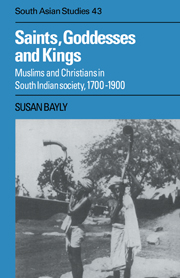Book contents
- Frontmatter
- Contents
- List of plates
- List of maps
- Preface
- Note on transliteration
- List of abbreviations
- Introduction
- Part I
- 1 South Indian religion and society
- 2 The development of Muslim society in Tamilnad
- 3 The Muslim religious tradition in south India
- 4 The south Indian state and the creation of Muslim community
- 5 Warrior martyr pirs in the eighteenth century
- 6 The final period of nawabi rule in the Carnatic
- Part II
- Select glossary
- Bibliography
- Index
- CAMBRIDGE SOUTH ASIAN STUDIES
- Plate section
3 - The Muslim religious tradition in south India
from Part I
Published online by Cambridge University Press: 04 December 2009
- Frontmatter
- Contents
- List of plates
- List of maps
- Preface
- Note on transliteration
- List of abbreviations
- Introduction
- Part I
- 1 South Indian religion and society
- 2 The development of Muslim society in Tamilnad
- 3 The Muslim religious tradition in south India
- 4 The south Indian state and the creation of Muslim community
- 5 Warrior martyr pirs in the eighteenth century
- 6 The final period of nawabi rule in the Carnatic
- Part II
- Select glossary
- Bibliography
- Index
- CAMBRIDGE SOUTH ASIAN STUDIES
- Plate section
Summary
Introduction
Chapters 4, 5 and 6 will look at the impact of eighteenth-century Muslim rulers and would-be rulers on south India's religious life. First, though, we must ask what kind of Muslim religious tradition had come into being in the Tamil country before the founding of the new Arcot regime. Although most of the region's Muslim groups took pride in the tradition of Islamic high culture which was fostered in the maraikkayar towns, this world of self-conscious Muslim adherence must be understood in terms of its close and mutually invigorating relationship with the pir cults of Tamilnad, and with the networks of pilgrimage and cult veneration which formed around the region's tomb shrines. In towns such as Kilakkarai and Kayalpatanam, for example, the devotees and pirzadas of the great Sufi dargahs and khanaqahs moved easily between the world of ‘high’ Islam and the supposedly humble ‘folk’ tradition of the unlettered Muslim ‘masses’. It is only in the most superficial sense that these constituted opposing levels of religious experience. Most of the region's major Sufi hospices and teaching institutions grew into celebrated cult centres and sites of miraculous healing and ecstatic devotional practice, while simultaneously acquiring fame as places of learning and instruction.
The aim of this chapter is to create a typology of south Indian Sufi cults and devotional traditions. This will be done in two ways: first, by grouping the region's cult personalities as figures in a specifically Muslim sacred landscape, and secondly, by showing how south India's Muslim cult traditions came to allude to and intersect with forms of Tamil faith and worship, that is, with forms of worship which would now be termed Hindu.
- Type
- Chapter
- Information
- Saints, Goddesses and KingsMuslims and Christians in South Indian Society, 1700–1900, pp. 104 - 150Publisher: Cambridge University PressPrint publication year: 1990



